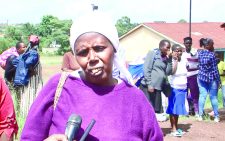Calving season in Serengeti National Park ends

The gnus were busy giving birth in southern Serengeti when TravelWise toured the park before the border was closed to contain Covid-19. Slow migration has since commenced northwards, reports HARRIET JAMES
“Mungu alipomuumba nyumbu, inasemekana alimuumba na mabaki ya wanyama wengine (when God created the wildebeest, it is believed He used the remaining materials used to create other animals)” begins my tour guide Ayoub Hosea.
We had stopped to watch a spectacle of gnus before us. They resembled thin, but muscular, cows with large sloping backs, curved horns and beards.
Its front legs looks like it originated from an ox, it back legs from an antelope, while the tail and mane resemble that of horses.
“Its horns are curved likes a buffaloes while its face looks like a grasshopper’s,” Hosea, who is based at Asilia Dunia Camp where I was residing during a recent tour of Serengeti National Park in Tanzania added.
I studied the gnus.The name comes from a South African tribe, the Khoikhoi who call it t’gnu.
Because of their wild appearance and vigorous nature, the Dutch re-named them wildebeest when they settled in South Africa.
It was one of the most challenging and informative game drives I’ve ever been on. Although both Tanzania and Kenyans speak Kiswahili, theirs is a bit different.
While we call a lion simba, they call it sharubu (masharubu) because of the beard.
So, whenever Ayoub met his fellow guides, he would ask them if they had seen any sharubu. So I had to sharpen my Kiswahili to understand the Tanzanians better.
Endless plains
It was my first time experiencing the wildebeest migration (or wahamiaji in Swahili) as Ayoub my guide taught me.

I’ve always missed it every time I landed in the Mara and having a chance to witness the calving season in Serengeti was magical.
The drive began very early as we were going to have a long day searching for the nyumbus at a place called korongo la kujificha (hidden valley).
We encountered gnu mothers making some sort of barricade around their calves.
The calves were yellowish brown and some were breast-feeding as others rested under a huge acacia tree.
It was the calving season and a magnificent view watching the large concentration of gnus in the field.
“They love this area because it’s an open field for giving birth. There is also plenty of grass and water, which they need for strength to feed their calves,” explained Ayoub
Known as the land that moves forever “endless plains or Siringeti” is an approximation of the word used by the Maasai to describe the area, Serengeti is just like the Masai Mara in Kenya, but so much bigger.
It is characterised by vast open savannas, acacia-studded grassland, scrubby hills and kopjes of various sizes.
The Serengeti has well defined routes for game drives and going off the track attracts penalties. This safeguards the migratory paths, minimising human impact in the park.
Statistics from the Tanzania Tourism board indicate that nearly 150,000-200,000 people visit the Serengeti each year, mostly during the calving season.
About 300,000-500,000 calves are born annually between January and February, according to National Geographic.

This means nearly 8,000 calves are born daily. Surprisingly, the calves walk on their own a few minutes after birth. Unlike other antelopes keen on isolated spaces, the cows give in the middle of the herd for protection.
In a few days, the calves can even outrun a lioness or other predator trying to make a meal out of them! They are also heavy, weighing about 20 to 22kg at birth.
It takes around six to nine months for a mother to wean her calf. From months, gnus mature and are ready to mate, with a lifespan span of about 20 years.
In the unfair twist of nature, the male calves are shooed away while their sisters stay in the herd.
We drove further to the south in Ndutu region just near Ngorongoro crater. Here we saw tens of thousands of gazelles as well as zebras, some expectant and others with their babies accompanying the wildebeest on the great trek.
Since they can’t camouflage in the environment, they live in herds and stomp or charge at a predator when they sense one.
They are also loud creatures who listen to sound alarms of other animals such as baboons to know when they are in danger.
Wildebeests shape up the Mara-Serengeti ecosystem as they move. While they feed on the grass, their droppings fertilise the land and they also become food for the predators who rely on them.
They settle in this area for about three months because the soils here are rich in nutrients and produce healthy grass —perfect for the calves to feed on and build up their strength quickly.
The grass also assists the lactating mothers ensure that they have abundance of milk rich in nutrients to feed their young ones.
As I got busy taking photos, my guide spotted activity around the carcass of an animal a distance away.
There were lots of flies in the area too, which Ayoub said was due to the many placentas in the location during calving seasons.
A flight of ruppells griffon vulture was fighting over the carcass of a gnu.
“Wanagombania kwasababu hawawezi kuchana ngozi. (The scramble is beacause their beaks are not sharp enough to tear the skin),” my guide said, taking a closer look with a pair of binoculars.
The vultures eat the softer parts such as the eyes first before going to the tougher parts.
“Vultures clean the ecosystem of carcasses and diseases. A disease can affect a wildebeest, but it can’t spread to the other gnus because it won’t affect the vultures when they eat them,” Ayoub said.
Serengeti Shall not Die
By the end of March, the southern Serengeti grass is exhausted and they once again begin marching in great lines in search for water, across central Serengeti.
By June, they cross the notorious Mara river, which everyone awaits for in the July to November tourism peak season.
With the increase in human population, there are fears that the pressure will reduce number of the wildebeests.
A decade ago, the herd was estimated at 1.5 million, but has since reduced to 1.2 million.
Climate change has resulted in unpredictable drought patterns and seasonal flooding, which threatens their population.
These challenges were foreseen long ago in 1960 Academy Award winning documentary dubbed, Serengeti Shall Not Die which alerted the world to the urgency of conserving the Serengeti.
The slogan has become popular ever since two Germans. Bernhard Grzimek and his son Michael wrote the book.
During the mating season, wildebeest are quite a bit more riled—herding, fighting, and calling to each other frequently.
An aroused bull will try to herd as many cows as possible, and will not sleep or eat for excitement if a female is nearby.















